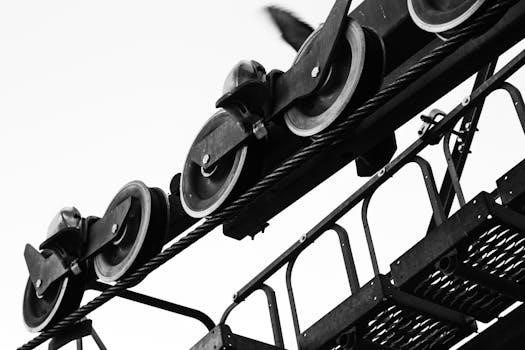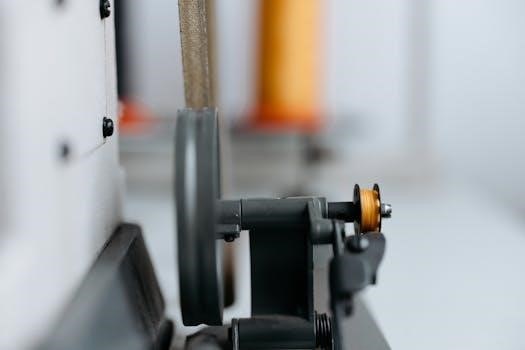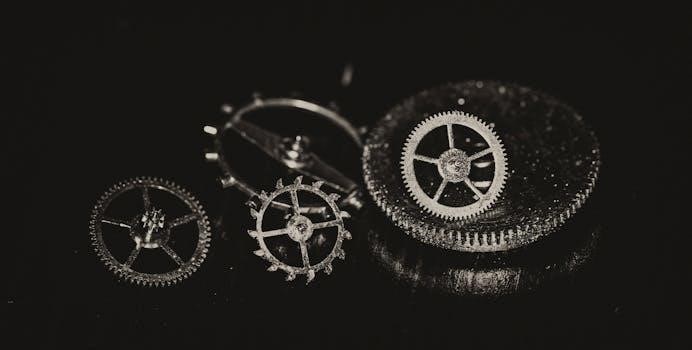Mechanical Aptitude Test Overview
Mechanical aptitude tests assess your understanding of physical and mechanical principles․ These often include questions on gears‚ pulleys‚ and their functions․ These tests evaluate problem-solving skills in mechanics․ They cover basic concepts like force‚ motion‚ and energy transfer and are widely used․
General Concepts Covered in Tests
Mechanical aptitude tests delve into fundamental concepts vital for understanding mechanical systems․ These tests often evaluate your grasp of forces‚ including tension‚ compression‚ and shear‚ which are crucial in analyzing how objects interact․ The tests also examine your understanding of motion‚ encompassing linear‚ rotational‚ and oscillatory movements‚ which are key to analyzing gears and pulleys․ Furthermore‚ they assess your knowledge of energy transfer within systems‚ considering how energy is converted and transmitted through mechanisms․ You will encounter scenarios involving simple machines like levers and inclined planes‚ which form the basis of many mechanical devices․ A significant focus is placed on the interactions of different mechanical components‚ such as how gears interlock and transfer motion‚ or how pulleys alter force and direction․ The tests also cover basic principles of physics that underpin these mechanical systems‚ testing your ability to apply theoretical knowledge to practical situations․ They measure spatial reasoning abilities‚ requiring you to visualize how components move and interact in three dimensions‚ which is essential for understanding mechanical diagrams and systems․ Additionally‚ understanding basic principles of fluid mechanics and electricity might be necessary for some questions․

Gears in Mechanical Aptitude Tests
Gears are a key component in mechanical reasoning tests․ Questions often involve understanding their function‚ direction of rotation‚ and speed․ These tests assess your knowledge of their interactions and applications․
How Gears Function in Mechanical Systems
Gears are fundamental components in mechanical systems‚ primarily used for transmitting rotational motion and torque between different parts of a machine․ They operate by interlocking teeth‚ which allow for precise and efficient power transfer․ The size and number of teeth on a gear directly influence its speed and force output․ Smaller gears rotate faster but with less torque‚ while larger gears rotate slower but with more torque․ Gears can change the direction of rotation‚ making them versatile for various mechanical applications․ They are used in countless devices‚ from simple hand-cranked tools to complex industrial machinery․ Understanding how gears interact is crucial for analyzing the overall functionality of a mechanical system․ In aptitude tests‚ questions often focus on identifying how gears affect rotational direction and speed‚ and how these interactions contribute to the overall system’s performance․ This knowledge is key to understanding complex mechanical systems․
Gear Rotation Direction and Speed
In mechanical systems‚ the rotation direction of gears is crucial for understanding how machines function․ When two gears mesh‚ they rotate in opposite directions․ If one gear turns clockwise‚ the gear it’s meshed with will turn counterclockwise‚ and vice versa․ This principle is essential when analyzing complex gear trains․ The speed of a gear is determined by its size relative to the gears it interacts with․ A smaller gear will rotate faster than a larger gear when they are meshed․ This relationship is inversely proportional⁚ the larger the gear‚ the slower its rotation․ Gear ratios are used to calculate the speed and torque changes between gears․ Understanding these principles is vital for predicting the motion within a system and is a common focus in mechanical aptitude tests․ Questions might require determining the final rotation direction and speed based on the layout of several gears․

Pulleys in Mechanical Aptitude Tests
Pulleys are essential components in mechanical aptitude tests․ These tests assess your understanding of how pulleys work․ Questions often involve analyzing direction of movement․ They also include force and mechanical advantage․
Basic Principles of Pulley Systems
Pulley systems are fundamental mechanical devices used to lift or move objects by changing the direction of a force or the amount of force required․ The basic principle behind pulleys is that they use a rope or cable that runs over a grooved wheel․ This wheel can be fixed or movable‚ depending on the system’s design․ A fixed pulley changes the direction of the applied force but does not reduce the amount of force needed․ A movable pulley‚ on the other hand‚ reduces the force required to lift an object but increases the distance the rope must be pulled․ These principles are crucial for understanding how simple and complex pulley systems work․ The number of ropes supporting the load determines the mechanical advantage․ This advantage is the ratio of the output force to the input force․ Understanding these basic principles allows one to solve various problems relating to pulley arrangements․
Analyzing Pulley Systems for Direction
Analyzing pulley systems for direction involves determining how the movement of one part of the system affects the movement of another․ In simple systems with a single fixed pulley‚ the direction of pull changes․ When you pull down on the rope‚ the load moves up‚ and vice versa․ However‚ in systems with multiple pulleys‚ the direction of movement can be more complex․ If the rope passes over a fixed pulley‚ the direction is simply reversed․ If it passes over a movable pulley‚ the direction is typically maintained or a combination of directions may be created․ Tracing the path of the rope through the system is crucial for understanding the direction each part will move․ By carefully observing the setup‚ one can determine the direction of the force and the resulting motion of the load․ The analysis includes identifying which parts are fixed‚ which are movable‚ and the path of the rope․

Calculating Forces in Pulley Systems
Calculating forces in pulley systems involves understanding how pulleys redistribute and reduce effort needed to lift loads․ In an ideal system‚ where friction and weight of the pulleys are ignored‚ the tension in the rope is uniform․ With a single fixed pulley‚ the force needed to lift the load is equal to the load’s weight․ However‚ each additional movable pulley reduces the force needed by approximately half‚ but increases the distance the rope must be pulled․ The mechanical advantage of a pulley system is determined by the number of rope segments supporting the load․ If there are ‘n’ segments‚ the force needed is roughly equal to the load divided by ‘n’․ This principle allows for lifting heavy objects with reduced effort․ To calculate the force‚ identify the number of supporting rope segments and divide the load weight by this number․ The ideal system ignores friction‚ but in real-world applications‚ friction will slightly increase the necessary force․

Example Questions
To understand how mechanical aptitude tests work‚ it is important to review example questions․ These include questions about gears and pulleys‚ demonstrating the practical applications of mechanical principles․ Here are some examples․
Sample Pulley Questions
Pulley system questions often appear on mechanical aptitude tests‚ focusing on your understanding of how pulleys work to change direction‚ force‚ and speed․ These questions may involve single pulleys or more complex systems‚ such as block and tackles․ You might be asked to determine the direction of movement of a load‚ the amount of force required to lift an object‚ or the number of support ropes in a system․ Some questions may assess your ability to analyze the tension in a rope‚ or the mechanical advantage gained by using multiple pulleys․ These questions are designed to evaluate your comprehension of fundamental mechanical principles‚ such as force transmission and the relationship between force‚ distance‚ and work․ Consider questions involving multiple pulleys to test your ability to calculate the effective force and the direction․ The pulley questions are essential for determining practical problem-solving skills․ Understanding the basic functions and principles is crucial for success in solving the problems․
Sample Gear Questions
Gear-related questions in mechanical aptitude tests often explore how gears transmit motion and change speed or direction․ These questions may involve determining the rotation direction of connected gears‚ or assessing how gear sizes affect the output speed․ You might encounter scenarios with multiple gears‚ or gears connected by a chain or belt․ Questions could require you to calculate the gear ratios to understand how they modify rotational speed and torque․ Some questions might test your comprehension of the concept of meshed and unmeshed gears‚ and how their arrangement changes the direction of rotation․ You might need to identify which gear will turn the fastest or predict the rotational direction of a final gear in a sequence․ These problems assess your understanding of mechanical principles‚ and your ability to analyze systems․ It is crucial to understand how gear teeth interlock and how this relationship impacts speed and direction․ The gear questions are essential for assessing problem-solving skills․
